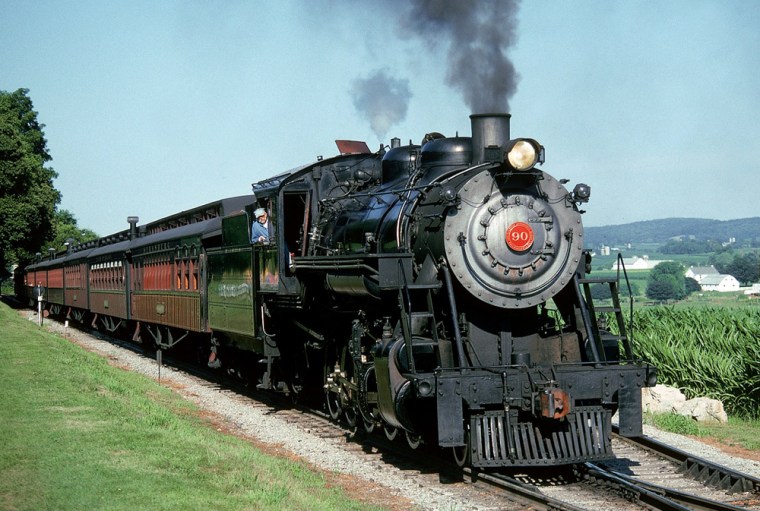Just keep chugging, and you could become a star.
From one career hauling sugar beets in Colorado, steam engine No. 90 now lives a more glamorous existence shuttling tourists back and forth to Paradise, Pa., on the Strasburg Rail Road.
As the engineer Russell Shurtleff eased 90 up the track one morning, the acrid coal smoke, the hiss of escaping steam, the clanging bell and especially the hoot of the whistle brought me back to being a kid half a century ago, marveling at this same engine as it went about its business in the Great Western Railway yard in my old hometown of Loveland, Colo.
"She's a living creature," Shurtleff said — a fancy encouraged by the thumping pulse of the engine's air compressor.
After decades of humble toil on the 63-mile Great Western line, No. 90 gained fame partly because of its unusual structure — it was a "decapod," with a single pair of pilot wheels and five pairs of driving wheels — but mainly because it was still around after bigger railroads in Colorado had scrapped or retired their steam engines.
After taking several curtain calls pulling railfan specials in the 1960s, 90 was sold to the Strasburg in 1967.
At 84 years old, it's the newest, biggest and most reliable beast in the Strasburg stable.
"It's probably the most used engine, and it is very reliable," said Linn Moedinger, Strasburg's president and chief mechanical officer. His assignment for the morning was to shovel coal into 90's hungry firebox — up to 800 pounds of it on a nine-mile roundtrip to Paradise.
"I would say that she has a fairly good attitude," he added. "I think we've put 400,000 miles on it since we've had it. She is pretty much our mainstay."
As sturdy and unpretentious as the furniture made by Amish craftsmen in the surrounding farmlands, 90 survived while many faster, more powerful and more famous engines succumbed to the scrapyard in the 1950s. The Great Western kept its fleet of four steam engines into the 1960s as standby power for the autumn "campaigns" of hauling beets to factories in northern Colorado, and all four have survived.
The 90 was the biggest Great Western engine at 180 tons fully loaded, and the oddest. Its decapod structure made it unique among the steam engines that worked in Colorado.
The Strasburg's $23,000 investment in buying the engine paid immediate dividends. Lovingly maintained by the Great Western, the engine went to work just nine days after arriving.
"It seemed like a big engine but actually it was perfectly suited to the Strasburg," Moedinger said. "Even though it's reasonably large, she is pretty light on her feet with a 17-ton axle loading, and these locomotives were designed to get a fair amount of power and run over a fairly light track structure."
The Strasburg bills itself as the nation's oldest short-line railroad, chartered in 1832 to connect the town to the Philadelphia and Columbia Rail Road — later absorbed by the Pennsylvania Railroad. Strasburg acquired its first passenger car in 1861 to ferry local people to Paradise to greet Abraham Lincoln as he made his way to Washington for his inauguration.
When the line was threatened with closure in the 1958, a group of enthusiasts including Moedinger's parents raised $18,000 to buy the weed-choked line, hoping to survive on freight business but quickly finding salvation in hauling people with steam engines — a machine that hadn't been seen on the Strasburg since 1926.
Over the years, the railroad expanded its attractions to include a dining car, wine and cheese specials, a restored executive car and a small blue engine with a happy face to lure the Thomas the Tank Engine set. The railroad also supports efforts to preserve the surrounding farms — the railroad's lush stage set — from development.
Strasburg was a homecoming for 90, which was built in June 1924 by the Baldwin Locomotive Works in Philadelphia, some 60 miles east.
At 84 years old, how much longer can 90 keep it up?
"Forever," Moedinger says.
Strasburg's shop crew takes pride in keeping its engines in prime condition, and has become so expert that it even helps the mighty Union Pacific maintain its two operable steam engines.
No. 90 helped in that process by wearing out the injectors that force water into the pressurized boiler. Strasburg's shop acquired the blueprints and started making their own.
Steam engines, with their simple technology, will be easier to maintain than sophisticated diesel engines.
"You're not going to manufacture a microchip in your basement, whereas you can turn a bearing on a lathe for a steam locomotive," Moedinger said.
Strasburg's shop crew is now working on a 109-year-old narrow gauge engine No. 20 from Colorado's legendary and long-defunct Rio Grande Southern, which he says will be an important learning experience.
"Part of our job is to be sure that we pass on whatever information we have learned, and that's a fairly high priority for all of us older heads who work at Strasburg," Moedinger said.
In a recent posting the Narrow Gauge Railroad Discussion Forum, Moedinger wrote that bringing that engine back to life is an emotional experience.
"Today I was sitting in the barrel while Brendan finished welding a straightening brace," he said.
"I thought of my dad's photo of number 20 that was on the cover of Trains magazine in 1941. I felt very privileged to be surrounded by the same steel that steamed past him when he snapped that picture."
